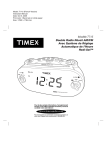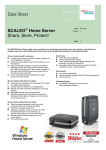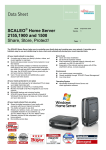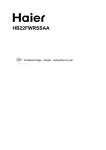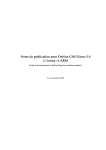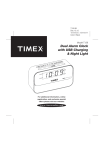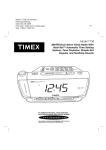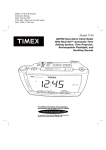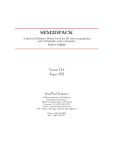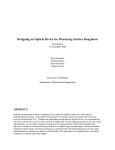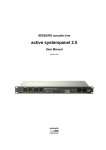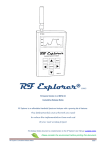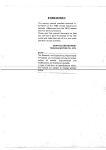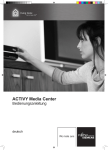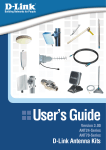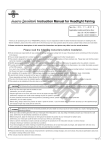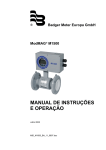Download Paper - HTML
Transcript
!"###$%%%&'()*+,-.'/,'0123+*)4+7).8/,-2'9/,3),3'0-,-:)*),3
5-,1-.;'<='>&&?
5-.+'62)+*/2&?<>A
!"#$%#$&'(")*+#,&+#&-+,+$./&0%1+.&2/.3%(*
4.(+&5/%+6"/.
CD!='!)2)E/**1,+E-3+/,8'(/F3G-.)'-,4'0123+*)4+-'(-)/.-3/.;
J-.+$K2)+*/2-L3*2$M13$F+
Abstract
Contemporary personal content libraries can hold tens or even hundreds of
thousands media items. It is increasingly difficult to locate individual items from a
collection of this magnitude, resulting a great demand for usable and attractive content
browsing user interfaces. This paper evaluates 14 consumer oriented media player
appliances and applications in order to find common patterns behind their conceptual
models, views and UI widgets. The evaluation method is informal, using hands-on
testing, user manuals and video review material. Unifying conceptual model is then
extended with external content aggregation. It was found that the players have
generally identical models, views and widgets, but the look and feel layer allows
product differentiation. It might also be beneficial to support non-deterministic and
content analysis based methods to augment the basic hierarchical and metadata based
browsing model.
#$''.,3./41E3+/,
An average gigabyte of storage space can hold 500 photos, 250 songs or 1.25 hours of video, or
any combination thereof. As the price of storage continues to drop rapidly, and less physical
space is required per gigabyte, 100 GB hard disks on portable devices are soon commonplace,
and network disks with terabyte capacity have been available for some time already. Equalling
50,000 photos, 25,000 songs or 125 hours of video for 100 GB, it is clear that browsing and
searching through such a collection requires sophisticated, usable and attractive user interfaces to
achieve efficient and entertaining user experience.
The aim of this paper is to provide an overview of personal multimedia collection browser UIs
available in present end-user media playback appliances and applications. Search and
personalization issues have been scoped out. First, players are classified into six categories, and
devices chosen for pattern observation are listed. A common unifying conceptual model for UIs
is presented, and its relation to metadata standards is then briefly discussed. Views to the
conceptual model are normalized, and navigation between them is examined in chapter 4.
Common properties of widgets and important differences are described as well. Chapter 5 points
out some problem areas in present digital media player UIs, and shows two alternative
approaches to content browsing.
#'B'#
Besides directly accessible audio, video and image items, local library often contains objects that
are stored on other physical media, like DVDs, CDs and VHS tapes, and there are dedicated
librarian applications to handle this material. Online and broadcast content should be accessible
ditto. Chapter 6 speculates whether this external content can somehow be integrated into the UIs
overviewed earlier. Chapter 7 proposes an aggregated multimedia content browsing model.
Finally, chapter 8 draws some conclusions.
A wealth of research effort has been put into usability testing, ethnographic studies and prototype
implementations of multimedia information retrieval systems. For example, Rodden and Wood
(2003) conducted a user study of a digital photograph collection management tool, which
employed the basic folder-, timeline- and thumbnail-based browsing. In addition, items could be
tagged with audio annotations that were later retrievable using text-based queries, and by content
analysis that provided similarity-based browsing. Surprisingly, the advanced browsing methods
were not commonly used, but browsing was rather based on specific events (which were
modelled by timeline and folder structures). Cunningham et al. (2004) studied organization and
access aspects of personal music collections in order to provide guidelines for system designers.
They argued that a rich set of browsing categories is required, and that the user should be able to
easily extend this vocabulary to gain more personalized browsing and sorting functionality. They
also stressed that the screen size should be considered as an important design factor for portable
devices. Lee and Smeaton (2002) describe a web-based video content browser for recorded TV
programs, and provide an interesting state-of-the art survey of digital video library applications.
However, despite of large amounts of reference material available, there are no compound
surveys investigating commercial media player content browser UIs that I am aware of.
>$''72-;).'92-88+F+E-3+/,
Media players were classified into six groups according to their portability, packaging and
storage capabilities (cf. table 1). Devices having storage capacity less than 10 GB were generally
Flash-based, while those with larger capacity used either embedded or external hard disks for
content storage. The difference between portable media players and centers is that the media
centers are more inclined to video viewing, and the difference between desktop media players
and PC-based media centers is that the former is usually run as a windowed desktop application
rather than in full-screen mode. Additionally, the latter has often support for TV broadcasts.
E-3):/.;
A'0/)+2)'/M/,)8
R'7/.3-)2)'*)4+-'/2-;).8
9'7/.3-)2)'*)4+-'E),3).8
V'9W'4)X+E)8
W'V)8K3//'*)4+-'/2-;).8
['79")-8)4'*)4+-'E),3).8
E-/-E+3;'P1RS
T'<
#'"''U
#&'"'U&
<&'Y'#Z&
#&&'Y'#&&&
#&&'Y'#&&&
//.3-)+2+3;
//.3-)2)
//.3-)2)
//.3-)2)
83-3+E
83-3+E
83-3+E
/-EK-:+,:
83-,4-2/,)
83-,4-2/,)
83-,4-2/,)
83-,4-2/,)
8/F3G-.)
8/F3G-.)
Table 1. Media player classification.
From each category, more than one device was selected for closer examination, which included
reading product user manuals and reviews, viewing usage scenario walkthroughs and product
marketing videos, and hands-on testing whenever possible. Some devices might be considered as
belonging to multiple categories, because of technological convergence. Table 2 lists the chosen
devices.
>'B'#
4)X+E)
(W'\U%&+
_/K+-'_U&
(/,;'7(7
(-,V+8K'(-,8-')>&&
0+E./8/F3'`1,)
A.EM/8'Z&<
9.)-3+X)'`),'A+8+/,'\
A//2)'+7/4'X+4)/
0)4+/,'0V9'<<&&
[('AE3+X;'0)4+-'72-;).'#%&
A//2)'+!1,)8'?
\+,4/G8'0)4+-'72-;).'##
\+,4/G8'09W
A//2)'[./,3'B/G
E-3
A
A
R
R
9
9
9
9
V
V
W
W
[
[
1R
#
>
>
U
&
&
&
U&
#Z&
)]3
)]3
)]3
)]3
)]3
4+8/2-;
><&] >&'P>^S
%>]<#Z'P>$#^S
<U&]>?>'P<$ ^S
>>&]#?Z'P#$U^S
>&]><&'P ^S
<U&]>?>'P<$ ^S
Z<&]<U&'P $?^S
>&]><&'P>$%^S
)]3
)]3
)]3
)]3
)]3
)]3
+,/13
K);8
K);8
K);8='3M1*)83+EK
GM))2='K);8
K);8
83;218='K);8
K);8
GM))2='K);8
.B'.)*/3)
.B'.)*/3)
*/18)='K);8
*/18)='K);8
.B'.)*/3)='*/18)='K);8
.B'.)*/3)='*/18)='K);8
Table 2. Devices chosen for examination. The third column shows internal storage capacity (or
ext if there is none).
$''9/,E)/31-2'0/4)2
A three level deep generalized model comprising Library, Container and Item was found to be
sufficient to describe the seemingly different internal structure of the players. The model is
shown in figure 1.
Figure 1. Conceptual model.
'B'#
The topmost conceptual item is Library, which comprises entire local personal content. Portable
devices are capable of holding only a subset of the Library in their internal storage at one time,
and for this reason, they ship with a content manager application (running in a PC) for
synchronization tasks. For iPods, this application is iTunes, for Microsoft's Plays For Sure
devices it is usually WMP, although most manufacturers offer also a branded custom application
for the purpose. In Creative Zen's content manager, Library is chunked into sublibraries (the
maximum size of one sublibrary equals the capacity of one Zen), allowing one of them to be
activated and transferred into the device. This is a brilliant idea, provided that sublibraries can be
cross-browsed in PC. FS Activy can address UPnP servers one at a time, but this can be
considered as a shortcoming, because server contents are totally independent of each other.
Furthermore, FS Activy relies on server to provide the content hierarchy.
The second highest conceptual entity (in hierarchy terms) is Container, which groups objects
according to some semantical reasoning. Container is either a flat ordered list of items (like
playlist or favourite channel list), or a hierarchical structure allowing nesting (like user-defined
tree of folders). There was a variation amongst players in the number of nested levels. Some
smaller capacity devices allowed hierarchical nesting for some media types but grouped other
types flat (Sansa), some restricted nesting level to one (Sony PSP). The most portable playlist
format was m3u. Playlists can be divided into user defined and automatic lists (including play
statistics, date and randomly generated lists).
The lowest level conceptual entity is Item, which can either be a MediaItem such as video, audio
or image object, or a supporting MetadataItem like artist or album. MediaItems are usually
atomic entities (which can be indexed with location bound markers such as chapters), but may in
some cases be nested in a hierarchical manner. For example, a classical composition may consist
of several movements. This was not utilized by any player under investigation, although the
latest version of iPod is able to play succeeding tracks without gaps in between, should that be
desired.
Common conceptual model was derived from DIDL-Lite (UPnP 2006), which combines
elements from UPnP content directory service, MPEG-21 DIDL and Dublin Core. Library,
Container and their subclasses are derived from object.container, Item and MediaItem are
descendants of object.item, and MetadataItems are derived from object.container.person and
genre classes. Only three elements do not exact equivalents in DIDL-Lite, and these are Video
Clip, Subtitle (which is a time bound collection of texts) and Cue Point (representing time bound
marker, such as chapter, section or repeat point).
<$''A+)G8'-,4'\+4:)38
<$#'A+)G8
The primary filtering criteria of the Library seems to be media types, i.e., Music, Videos and
Pictures. Some players include also top level choices of Recorded TV Shows, Radio, Podcasts
and Audiobooks. The primary filtering criteria is mandatory, but succeeding criteria may be
bypassed by selecting ‘All Items’.
The secondary filtering seems to be done according to Genre, or by Keyword if browsing
Pictures. The third filtering option depends on the primary criteria, except that Ratings is
available for all media types. For Music, items can be grouped by Artists/Albums, Year/Albums
or by Albums directly (additionally by Composers or by Contributing Artists). Videos can be
arranged by Actors/Movies or Artists/Albums in case of music video clips. Pictures can be
<'B'#
viewed by Album or Date. TV Show items are actually Episodes, which can be grouped by
Actors/Shows/Season or Shows/Season. Radio items are live web streams that can be arranged
by Stations (or channels). Player might provide also folder and device –based views, which are
located at filtering secondary level.
The result view of filtering actions shows the (playable) media items and their most important
attributes (number, title, duration, filtering criteria attributes, description, statistical info). Item
list may be sorted according to any attribute, and in some cases, user can personalize what
attributes to include in view. The result group is treated like a playlist, and might be storable for
later retrieval. In general, Playlists can be selected either at the top level, or below media type
(e.g., Music/Playlists, effectively disabling cross media type lists).
Now Playing screen is dependent on media type. For music tracks, usually track number, title,
album, artist and duration are displayed. Current position with progress slider is common as well,
and album art is displayed if it is available. Music tracks may show also visualization effects. For
videos and pictures, now playing is usually shown as OSD textual information.
<$#$#'_-X+:-3+/,'R)3G)),'A+)G8
Switching to another primary filtering criteria was possible only via top level view, and in most
cases, user has to navigate from result view to the top, and then downwards again. This takes at
least four navigation steps in most portable players, and might take even as much as eight.
Secondary filtering criteria switching takes half of that, although Zune provides a usable
horizontal navigation shortcut called twist (cf. 4.2.1).
<$>'\+4:)38
The choice of widgets is influenced by available input mechanisms and by the amount of screen
estate. Despite visual differences, the underlying principles of interaction were in general the
same in all players, and the widgets could be divided into standard controls (tree, list, grid) and
into planar and pseudo 3D controls. Popup menus, buttons, layout controls were naturally used
as well, but they were not analyzed.
<$>$#'(3-,4-.4'9/,3./28
Tree widgets are capable of expanding and collapsing parent nodes in order to show or hide child
nodes that lie beneath them. Child nodes are intended to the right to indicate their position in the
hierarchy. Each tree item consists usually of an expansion handle, an icon and a text label. Lines
may be drawn so that the tree structure is more clearly visible. Tree widgets were employed only
by desktop media players and Archos, because the most convenient input device in this case is
the mouse or stylus (albeit they do have keyboard interface as well). They also require a fair
amount of screen space.
List widget groups items into a scrollable vertical one-column array, allowing user to select one
or multiple choices. Activation is a two step process: item is first highlighted by single click, tap
or cursor key press, and then clicked or tapped again (constituting a double click) to select it.
Keyboard interface binds either right arrow key or enter/ok key for select action. For output, item
may consist of an icon/thumbnail and one or two lines of text. Some small screen devices
provided ticker-like automatic scrolling to reveal hidden parts of the text label. Two column
items were used to indicate name and value pairs.
%'B'#
List widgets were the most common controls in devices that were investigated. This is because
they adapt well to keyboard input mechanism, require only relatively small screen space, have
fixed visible size, and because navigation, choice selection and invocation actions can all be
made using just a single control. Their downside is that if they are used in hierarchy browsing,
there is no indication of current level. This was handled in some cases by setting the caption of
the control to current navigation path. SE W850i uses symbolic icons for indication.
List can also be horizontal. Zune has a clever option that reduces number of clicks when
navigating between different sibling views of single parent. At the top of the display there is a
horizontal strip (‘twist’), and beneath that, a vertical list of choices. When user selects an item
from the list, list contents are transposed into horizontal list that is displayed in twist (current
selection is highlighted), and items belonging to the selected are shown in the vertical list. Right
and left arrow keys are used to navigate the twist (i.e., to change parent level), and up and down
keys to navigate the list (i.e., to make a choice and possibly a transition into a new twist/list
pair).
Grid control is a multicolumn list widget. It is best suited for displaying items (rows) that have
similar attributes (columns). Choice of attributes can be personalized. The downside is that the
control requires large amounts of display space, and for this reason, they were only used by
players that had external displays.
Figure 2. Standard widgets. a) tree b) list c) twist d) grid
<$>$>'72-,)'-,4'78)14/' V'9/,3./28
Icon or image arrays are best suited for top level selections or to situations where individual
items are different from each other and can thus be indicated by different graphics. Top level
choices can also be presented by special list style controls, where viewport stays at a fixed
position at the center of the screen, and the world behind the viewport is scrolled.
Sony PSP and some parts of Windows MCE use the entire screen space for navigation. Available
categories and options below each category are gathered into a 2D grid. Once again, the viewport
stays at a fixed location, and the grid below the viewport is scrolled in xy-plane. Only currently
active column and row are visible, forming a cross of categories and currently available options
(these may even be translucent). Navigation is done using arrow keys, and animation is provided
for additional screen candy.
Z'B'#
Figure 3. Plane widgets. a) image array b) fixed viewport c) cross
Finally, iTunes and FrontRow contain pseudo 3D user interfaces for top level and cover art
based browsing. In FrontRow, the top-level selection of media type (Music, Videos, Photos,
DVD) resembles a rotating carousel seen from a lifted position from horizontal level. iTunes 7
contains a ‘cover flow’ view that shows a stack of CD covers (arranged by artist or by album) in
tilted perspective, with the currently selected one in the middle. Covers can be browsed using a
scrollbar showing an attractive animation effect.
Figure 4. Pseudo 3D UIs. a) carousel b) cover flow
%$'7./)2)*'A.)-8'-,4'(/*)'A23).,-3+X)'R./G8+,:'(/213+/,8
Some problems were noticed during analysis. Because top level choice (usually Music / Videos /
Photos) has to be made before any other filtering action, there is no option to browse the entire
collection. For example, it is impossible to list all media items of specific artist. iTunes groups
music tracks and music videos under top level Music category if metadata for the video clip has
been set up properly, but in general, cross browsing has to be made using text search
functionality. Chapter 7 proposes a browsing model that allows any second level filter collection
to be used as the primary sorting criteria.
Another problem is that connected devices and applications in categories D-F do not facilitate
browsing across multiple media servers. FS Activy 150 can address only one UPnP server at a
time, and one has to navigate through setup screens to acivate another server. While source based filtering might be desirable, it should be included as a top level filtering criteria, and
ANDed with media type selection. This is also addressed by the proposed model of 7, and has
already been implemented in TVedia (cf. chapter 6.1). Among other integration features, TVedia
allows also iTunes FairPlay and Windows Media DRM -protected content to be accessed using a
single player interface, which is impossible in all players under investigation.
?'B'#
Furthermore, all browsing was based on metadata or on user-defined folder structure. This might
be sufficient in most cases (as metadata creation can be automated and seems to be remarkably
well supported in content manager applications and software -based players). Advanced content
analysis algorithms can provide additional information that is not supported by metadata, and
this option was totally ignored in most players. SE W850i utilizes a web service that can identify
a piece of music from a short sampled fragment of a song, and provide accurate metadata that
can then be used in purchasing or subscription transactions. One example of combined content
and metadata based browsing interface is illustrated by Artist Map, which is briefly described in
chapter 5.1 below.
Finally, automatic smart playlist creation was supported by many players, and is taken to the
extreme by iPod Shuffle which works on the assumption that user often wants to listen to
something, rather than to browse his way to a specific item. Probabilistic or statistic playlist
creation can provide unexpected and fresh ways to experience content, but as the sizes of
libraries continue to grow and online subscription services and communities make available
selection still wider, entirely new ways of browsing might be considered. Musicream described
in chapter 5.2 takes such a novel approach.
%$#'A.3+83'0-/
Artist Map visualizes music collection in form of 2D map, organized into clusters based on
similarity (van Gulik et al. 2005). Mood, genre, year and tempo can be used as categorizing
criteria, where latter is taken from content analysis. Two of these categories (e.g., year and
tempo) can then be chosen to define x and y axels, or one of them can be used to define a circle
across the visible plane (e.g., genre). Predefined anchor points provide the scale, and behave like
magnets to populate the space with individual items from media collection (visualized as colored
spheres, cf. figure 5). Artist names are overlaid atop of the visualization. Stylus is used as an
interaction device, and user is able to zoom and pan to see different portions of the collection.
Figure 5. Artist Map. The path in right represents a playlist.
%$>'018+E.)-*
Musicream allows probabilistic source material selection, similarity-based (meta) playlist
creation and management, and browsing and replay of past music listening sessions (Goto 2005).
Figure 6 shows screenshots of the main functionality of the UI, although a better way to
understand the dynamics is to view presentation videos available from referenced site.
U'B'#
Figure 6. Musicream UI.
The right side of the UI contains three taps, which drop continuous probabilistic stream of media
items in three different moods. The user can actively select items from these 'recommendations',
view their metadata and listen to them. When he finds an interesting item, he can pick it up and
drag it around to make a contact with other discs falling from the taps. If the similarity between
discs is high, they affect each other like magnets, while those having less similarity have to make
contact many times. The discs that have made a contact stick together like pearls in a string, and
the collected playlist can be dragged as a whole to an empty position at the left side of the
screen. The user is then able to rearrange, remove, and start playback from any position in the
list.
Multiple playlists can be arranged into the left space this way, and a series of playlists can then
be played back in top-to-bottom order. Horizontal playback bar can be dropped from the top of
the screen to start the playback. After playback bar reaches the vertical center position of a disc
string, playback is started from the first disc, and then continued through the playlist in
horizontal direction. When last disc in a row has been played, the bar continues towards the
bottom part of the screen, stopping whenever encountering an active playlist, and starting the
playback for that playlist.
Finally, Musicream records each action made by the user, and allows backwards browsing in
time to recall scenes from the past. There are two sliders that allow coarse (date) and fine (time)
scale browsing. By clicking a specific media item, usage-based search and similarity based
search is triggered simultaneously from the pool of previous activities. Usage matched scenes are
presented as thumbnail screenshots at the left side of the UI, while similarity based search results
a row of screenshots that are displayed horizontally at the bottom of the UI.
Z$'W]3).,-2'9/,3),3
Previous chapters have concentrated on local content that either resides in player's internal
storage, or is accessible via LAN using PC file sharing or UPnP media server functionality.
However, personal multimedia content is not always in a format that can be consumed by the
media player engine. External DVDs, CDs and VHS tapes can be managed using dedicated
librarian applications that are able to fetch metadata information from online databases, and
provide advanced cataloguing, browsing and searching services through proprietary user
interface. Personal content is also increasingly being published in internet shares such as Flickr
and YouTube, and membership in online communities is bound to widen the scope of personal
content. Furthermore, online stores, VoD, Podcasts, live internet radio and television streams,
P2P distribution and DVB companies offer content that is likely to be added into one's personal
multimedia library.
It would be beneficial, if external offline and online content could be browsed in parallel and in
the same manner as local content. This is to some extent already possible in PC-based media
centers and portable media device content management applications, as online stores and
C'B'#
subscription services are part of the companies' business models (e.g., iTunes Store, Zune
Marketplace, MCE online spotlight). There are also some third party plugins available for PC
media centers that allow photo or video browsing and streaming from online communities. They
are not entirely consistent with the user interfaces used in local content browsing, however. The
following two solutions integrate external and local content more seamlessly.
Z$#'!A)4+TVedia is described as networked media center PC software (8 Dimensions 2006), which is able
to access local content from shared network directories, multiple UPnP content directories, and
protected material in both Windows Media DRM and iTunes FairPlay formats. It is also capable
of browsing online content sources such as Flickr, YouTube, Google Videos, Live365 and
Last.fm, and fetch metadata from Amazon and AMG. All browsing is done using centralized UI
front end (open source XML and JavaScript), which has been designed to scale for both 10-feet
and windowed desktop resolutions. Local content is served as an aggregate UPnP content
directory (which can be browsed and searched), so the internal data structure is built on top of
DIDL-Lite concepts.
Figure 7. TVedia UI.
Z$>''7M+2+/8'(+F)(3;2)'C/*)'0),1
LifeStyle Home is Philips' research project that visions a concept for connected living (Philips
2006). The centerpiece of user experience in their concept is network enabled TV, which
displays personalizable home menu, allowing access to local, online and broadcast content, and
management of peripheral devices such as lighting or digital media frames. TV screen is divided
into horizontal strips, one for each category (e.g., live TV, music, videos, photos, movies, online
services, devices). Each strip or category is divided into frames, where the center one contains
'now Playing' thumbnail, and pressing left or right in remote control scrolls previous or next item
into the center. Pressing remote's up and down buttons allows navigation between categories, the
active one is expanded vertically. User is able to personalize which categories are visible, their
vertical order, create new ones and fill them with local or online content and services. The latter
are CE-HTML compatible web services, which are initially accessible from 'catalog' strip
comprising individual services grouped into 'genres' as frames. Examples of genres are web
radio, VoD, eBooks, News and Entertainment.
#&'B'#
Figure 8. Philips LifeStyle Home Menu.
The system contains also a dedicated full screen music browser UI (cf. figure 8), which allows
access to local and online music albums, tracks or videos. This pseudo 3D UI is visualized as a
large wheel of album covers, which can be rotated horizontally (using different speeds). Music
can be sorted at least by title and genre. When desired item is found, it is expanded and playback
starts automatically. If selected item is an album, its tracks can be browsed with up/down
gestures. There is another larger wheel of items available for online store browsing, and when an
item is purchased, it is automatically transferred into the local library, making it available in the
smaller wheel as well. Navigation input device is a transparent, tactile gesture-driven 2D
touchpad.
?$''A::.):-3)4'9/,3),3'R./G8+,:'0/4)2
As discussed earlier, current players do not facilitate cross browsing over entire media collection.
This can be easily overcome by adding ‘All Media Types’ option to the top-level choices (beside
Music, Videos, Photos and so on). This allows direct second level filtering, and queries such as
‘all works by a specific artist’.
Other problem with present players is that they do not allow browsing across multiple media
servers, and if they do, there is no way of browsing contents of a specific server. This can be
solved by ANDing a ‘Media Source’ filter to the primary criteria, and as above, it has the option
‘All Servers’ to bypass, which is also the default. To support external content browsing, class
hierarchy might look like the one in table 3. When referencing content, items should be prefixed
with Media Source id. This must be done, because for example UPnP id uniqueness is
guaranteed only within single server.
E2-88
0)4+-(/1.E)
V)X+E)
D7,7().X).
0/)+2)7M/,)
A//2+E-3+/,
\))().X+E)
4)8E.+/3+/,
-)83.-E3
-)83.-E3='M+4)8'*+442)G-.)'/-.2-,E)
D7,7'AA'9/,3),3V+.)E3/.;().X+E)'YE/*/-3+)2)'4)X+E)'B'-//2+E-3+/,
)$:$'8+*/2)'C!0('T12dT2+d'3-::+,:'E/,3),3'8).X).
)$:$'+!1,)8'/.'VAV'2+).-.+-,
)$:$'[2+EK.='E/1!1))='(+X) Z%
Table 3. Aggregated Content Model
Using above augmentations for cross media type and multiple server browsing, for example
following queries are possible (in SQL): select title from MediaItem where author =
‘artistName’ (without additions, MediaItem would not be directly queryable, and one would
need to address one of its subclasses instead). select href from Library where
MediaSource.class = ‘WebService’ and title contains ‘iPod’ (this is a pseudo query,
which translates into WSDL or REST requests for all supported online content servers).
##'B'#
U$''9/,E218+/,8
Because underlying data set is more or less equal in all digital media players, it was possible to
derive a common conceptual model that covers individual player functionality almost entirely.
Views and widgets were also found to be basically similar. However, no two players look and
feel alike (user interface is one of the discriminating factors for manufacturers), and it was noted
that some players offer smoother browsing experience than their rivals do.
Some problems were found in browser implementations, relating to cross media type, cross
media server and external content addressing. Simple additions to the base conceptual model can
offer this functionality.
As personal multimedia content libraries continue to grow in size, novel ways of browsing and
choosing content should be utilized. In addition to hierarchical metadata based browsing, it may
be beneficial to use methods that provide non-deterministic recommendations and choices based
on similarity, style, mood and tempo. To provide this flexibility, efficient back end data mining
algorithms and databases are needed.
B)F).),E)8
8 Dimensions (2006). TVedia Homepage. [online]. M33/FBBGGG$U4+*$E/*.
Cunningham, S.J.; Jones, S.; Jones, M. (2004). Organizing digital music for use: an examination
of personal music collections. Proc. of ISMIR 2004. October 10-14, 2004. Barcelona, Spain.
Available: M33/FBB.8*+.>&&<$+8*+.$,)3B/./E))4+,:8B/&U>"/-:)"<<?"/-/).>>#$/4F
Goto, M. and Goto, T. (2005). Musicream: New Music Playback Interface for Streaming,
Sticking, Sorting, and Recalling Musical. Proc. of ISMIR 2005. September 11-15, 2005. London,
UK. Available: M33/FBB+8*+.>&&%$+8*+.$,)3B/./E))4+,:8B#&%U$/4F$ Video demonstrations available at
M33/FBB83-FF$-+83$:/$J/B*$:/3/B.(0.B>&&%B$
Lee, H. and Smeaton, A.F. (2002). Designing the User Interface for the Físchlár Digital Video
Library. Journal of Digital Information. Vol 2, No 4, 2002. Available:
M33/FBBJ/1.,-28$342$/.:BJ/4+B-.3+E2)BX+)GBJ/4+"% B%?
Philips (2006). Lifestyle Home. Available:
M33/FBBGGG$4)8+:,$/M+2+/8$E/*BB-88)38BV/G,2/-4-)2)F+2)BB(+F)83;2)C/*)g)./EM1.)"#<&<?$/4F
Rodden, K. and Wood, K. R. (2003). How do people manage their digital photographs? Proc. of
ACM SIGCHI conference on Human factors in computing systems. April 5-10. 2003. Ft.
Lauderdale, USA. Available: G))$*+3$)41B)),32);BGGGB*/)+2)B/-/).8B./44),>&& $/4F
UPnP Forum (2006). UPnP AV Content Directory Service Template. version 2.0. Available:
M33/FBBGGG$1/,/$/.:B8/)E8B-XBD7,7"-X"9/,3),3V+.)E3/.;"X>"().X+E)">&&Z&% #$/4F
van Gulik, R. and Vignoli, F. (2005). Visual Playlist Generation on the Artist Map. Proc. of
ISMIR 2005. September 11-15, 2005. London, UK. Available:
M33/FBB+8*+.>&&%$+8*+.$,)3B/./E))4+,:8B>&##$/4F$
#>'B'#
D8).'0-,1-28&P.)F).),E)4'5-,1-.;'<='>&&?S
Apple (2006). FrontRow [online]. M33/FBBGGG$-//2)$E/*B+*-EBF./,3./G$M3*2
Apple (2006). iTunes 7 [online]. M33/FBBGGG$-//2)$E/*B+31,)8B/X).X+)GB
Apple (2006). iPod Features Guide. Available:
M33/FBB*-,1-28$+,F/$-//2)$E/*B),B+7/4gP(-3)g>&&ZSg[)-31.)8g11+4)$/4F
Archos (2006). Archos 604 User Manual. Version 2.1. Available:
M33/FBBGGG$-.EM/8$E/*B81///.3B4/G,2/-4B*-,1-28B),:2+8Mg"g18).g*-,1-2g"g-.EM/8g%&<"Z&<g"
gX>$#$/4F
Creative (2006). Zen Vision W User’s Guide. Available:
M33/FBBF+2)8>$)1.//)$E.)-3+X)$E/*B*-,1-24,B0-,1-28B!(VBCUZUB&]W&<>#R<%B`),H>&A+8+/,H>&\H>&D8
).8H>&11+4)H>&W,:2+8M$EM*
Fujitsu Siemens (2006). Activity Media Player 150 User Manual. Available: M33/FBBGGG$F1J+381"
8+)*),8$F+B81///.3B*-,1-28$M3*2
Medion (2005). MDC 4400 PVR Käyttöohje (in finnish). Available: M33/FBBGGG$8EM,)+4)."
F+,$F+BGGGB/./-33$/M/I+4J# %
Microsoft (2006). Zune How-To [online]. M33/FBBGGG$k1,)$,)3B),"18B81///.3BM/G3/B/2-;B4)F-123$M3*
Microsoft (2006). Windows Media Player 11 [online].
M33/FBBGGG$*+E./8/F3$E/*BG+,4/G8BG+,4/G8*)4+-B/2-;).B##B4)F-123$-8/]
Microsoft (2006). Windows Vista Media Center [online].
M33/FBBGGG$*+E./8/F3$E/*BG+,4/G8X+83-BF)-31.)8BF/.M/*)B*)4+-E),3).$*8/]
Nokia (2006). N80 User Guide. Available:
M33/FBB,48#$,/K+-$E/*B/M/,)8BF+2)8B:1+4)8B_/K+-g_U&"#gD1g),$/4F
SanDisk (2006). Sansa e200 User Guide. Available from
M33/FBBGGG$8-,4+8K$E/*BA88)38B[+2)B/4FB:1+4)8B>%CC>g8-,4+8KgW>&&gW_1(.(CH%RW_H%V$/4F
Sony Ericsson (2006). W850i User Guide Add on. Version R1a. Available:
M33/FBBGGG$8/,;).+E88/,$E/*B4/G,2/-48B\U%&+ggD1gA44l,gB#-gW_g#>$/4F
Sony (2005). PlayStation Portable Instruction Manual. PSP-1001 K. Available:
M33/FBB2+)$83/.)$;-M//$,)3B2+)B83-.)-33).;B/8/$/4F
# 'B'#













